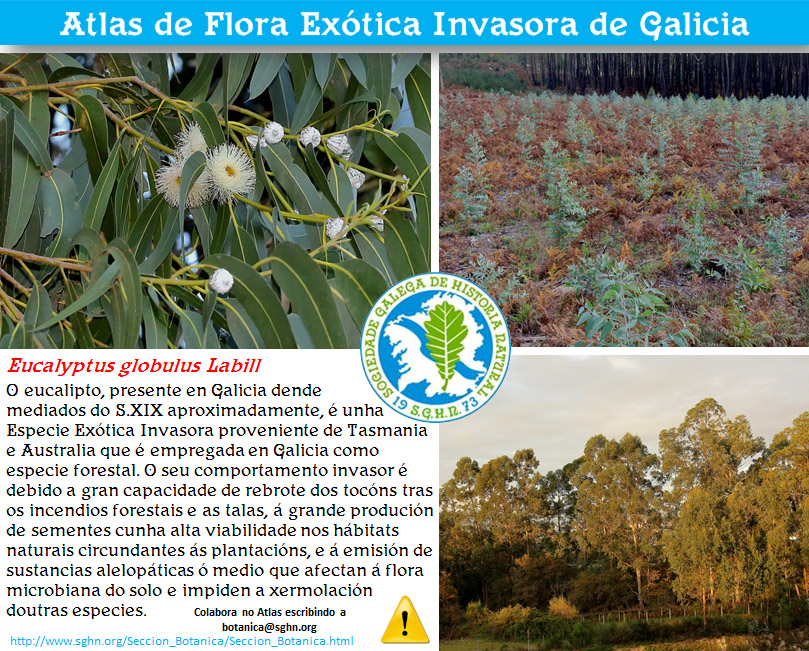Law 42/2007 and Royal Decree 630/2013 define “invasive alien species” as “an alien species that is introduced or established in an ecosystem or natural/semi-natural habitat, and which is an agent of change and a threat to native biological diversity, either by its invasive behaviour, or by the risk of genetic contamination”. Likewise, EU Regulation n. º 1143/2014 establishes that “invasive alien species” is “an alien species whose introduction or propagation has shown to be a threat or to cause adverse effects on biodiversity and associated ecosystem services”.

Collaborate on the Atlas by writing to botanica@sghn.org
The eucalyptus, whose presence in Galicia dates back to the mid-19th century approximately, is an Invasive Alien Species that comes from Tasmania and Australia. In Galicia eucalyptus are used as a forest species. Its invasive behaviour is due to the great capacity of the stumps to bounce back after forest fires and cuttings, to the large production of seeds with high viability in the natural habitats surrounding the plantations, and to the emission of allelopathic substances into the environment that affect the microbial flora in the soil and prevent the germination of other species.
All eucalyptus species are native to Australia and nearby islands. Their expansion into the rest of the world is due to human intervention. Therefore, all eucalyptus in Galicia are exotic species.
The ability of Eucalyptus globulus to colonise areas outside plantations and to self-propagation (naturalisation) within and around plantations. Thus, very high densities propagules have been detected in the outlines of the plantations (especially in a 15-meter strip, but with colonisations up to 80 m away). This indicates the presence of seedlings in 60% of transects along roadways, and that both propagation and establishment are greatly aided by the fires. Therefore, taking into account the magnitude of the surface today occupied by eucalyptus (425,000 hectares in pure or mixed stands), its wide dispersion throughout the 3 coastal provinces, the very high incidence of forest fires (half of those in the whole of Spain in less than 6% of the surface area), and the extensive roadway network (almost 50,000 km), the conditions in Galicia are perfect for eucalyptus to show their full invasive capability.
It is also well studied that eucalyptus are an agent of change and a threat to indigenous biodiversity and natural ecosystems. Therefore, all eucalyptus in Galicia are exotic species. Galician Society of Natural History (SGHN in Galician) considers that:
- Eucalyptus must be included in the catalogue of invasive alien species.
- Administrations must start actions for their control and subsequent eradication.
However, we might take into account the Galician reality and the socio-economic situation related to eucalyptus plantations, and therefore precise provisions should be adopted and sufficient time allowed minimising the economic impact on farm owners and industry.
On the basis of the foregoing, SGHN considers essential that, from now on, administrations must:
- Ban new eucalyptus plantations throughout Galicia.
- Eliminate eucalyptus from all publicly owned land.
- Demand the elimination of all eucalyptus plantations that do not comply with current legal regulations.
- Encourage the elimination of all eucalyptus in protected natural areas.
- Allow the exploitation until the end of the cutting season in the rest of the current plantations, exercising exhaustive control to prevent their expansion into neighbouring areas.
- Plan a progressive reduction in the surface area currently occupied by eucalyptus plantations in order to guarantee their eradication within a realistic time horizon.
Text translated by Sara Santos Trota (student of the Degree of Translation and Interpretation of the University of Vigo)
To find out more:
- Águas, A., Ferreira, A., Maia, P., Fernandes, P.M., Roxo, L., Keizer, J., Silva, J.S., Rego, F.C., Moreira, F., 2014. Natural establishment of Eucalyptus globulus Labill. in burnt stands in Portugal. Forest Ecology and Management 323, 47-56.
- Águas, A., Larcombe, M.J., Matias, H., Deus, E., Potts, B.M., Rego, F.C., Silva, J.S., 2017. Understanding the naturalization of Eucalyptus globulus in Portugal: a comparison with Australian plantations. European Journal of Forest Research 136, 433-446.
- Calviño-Cancela, M., Lorenzo, P., González, L., 2018. Fire increases Eucalyptus globulus seedling recruitment in forested habitats: Effects of litter, shade and burnt soil on seedling emergence and survival. Forest Ecology and Management 409, 826-834.
- Calviño-Cancela, M., Rubido-Bara, M., 2013. Invasive potential of Eucalyptus globulus: Seed dispersal, seedling recruitment and survival in habitats surrounding plantations. Forest Ecology and Management 305, 129-137.
- Catry, F.X., Moreira, F., Deus, E., Silva, J.S., Aguas, A., 2015. Assessing the extent and the environmental drivers of Eucalyptus globulus wildling establishment in Portugal: results from a countrywide survey. Biological Invasions 17, 3163-3181
- Fernandes, P., Antunes, C., Pinho, P., Maguas, C., Correia, O., 2016. Natural regeneration of Pinus pinaster and Eucalyptus globulus from plantation into adjacent natural habitats. Forest Ecology and Management 378, 91-102.
- Silva, J.S., dos Santos, P., Serio, A., Gomes, F., 2016. Effects of heat on dehiscence and germination in Eucalyptus globulus Labill. International Journal of Wildland Fire 25, 478-483.
- Ley 42/2007, de 13 de diciembre, del Patrimonio Natural y de la Biodiversidad.
- Real Decreto 630/2013, de 2 de agosto, por el que se regula el Catálogo español de especies exóticas invasoras.
- Reglamento (UE) nº 1143/2014 del Parlamento Europeo y del Consejo de 22 de octubre de 2014 sobre la prevención y la gestión de la introducción y propagación de especies exóticas invasoras.






